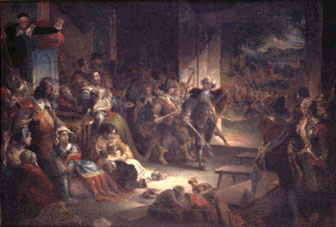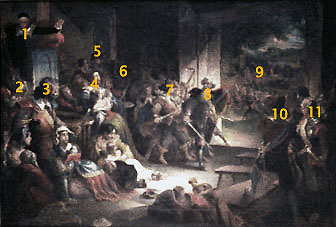The Painting

The “Angel of Hadley,” also known as “The Perils of our Forefathers,” hangs in the Hampshire Room for Local History at Forbes Library. It is painted in bituminous oil paint on wax lined linen and measures 18” X 26”. It was painted by Frederick A. Chapman sometime around the year 1850. Chapman, known for his stained glass design and historical, portrait, and landscape paintings, was born in Connecticut in 1818. In 1850 his historical and landscape paintings were exhibited at the American Art Union. He was the first president of the Brooklyn Art Association. In his later years, his oil paintings of Civil War scenes earned him considerable recognition. Chapman died in 1891.
Catalog record for the painting
The Legend
The legend of the Angel of Hadley has fascinated historians and locals for over three hundred years. It was this fabled event of King Phillip’s War, that supposedly occurred in September of 1675, that Chapman focused on in his painting of an Indian attack upon the town of Hadley. The scene depicted in the painting is that of the residents of Hadley attending service when an elderly stranger suddenly appears telling of the imminent attack. The stranger, who is dressed in outdated English clothing, leads a successful defense of the town and then vanishes as quickly as he had appeared, never to be seen again. While the grateful townsfolk were sure the man had been sent as an angel of God to save them, supposedly the real story came out years later as the pastor of Hadley, John Russell, lay on his death bed. It was only then that he admitted to harboring the English regicides, William Goffe and Edward Whalley, both with prices upon their heads for being the ruling judges in the decision to execute King Charles I. Allegedly they were hidden in a secret room in Russell’s home, where they both eventually died. Goffe emerged only that once to warn the town of the imminent attack of the Indians.
The Truth
Apparently none of this story is based in fact. There is no record of an Indian attack on Hadley in 1675. The myth seems to have been started in the following century when Ezra Stiles, President of Yale University, published “The History of the Three Judges.” President Stiles based his statement about the incident on an anecdotal footnote in a 1764 work published by Massachusetts Governor Hutchinson. Several venerable authors also made use of the legend, including Nathaniel Hawthorne.

Key to The Perils of Our Forefathers
From an engraving after the Chapman painting, published by John C. McRae in the 1850s
- Russell, Pastor.
- Ebenezar White, Wife & Child.
- Col. Church and family.
- Major Pinchon, (at that time sick)
Wife & Daughter. - Elder Davenport.
- Dr. Brewster.
- Captain Lathrope.
- Genl. Goffe.
- Indians, village & surrounding scenery.
- Capt. Gardiner.
- Capt. Talbot.
